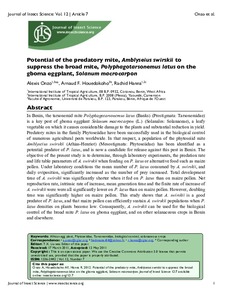| dc.contributor.author | Onzo, A. |
| dc.contributor.author | Houedokoho, A. |
| dc.contributor.author | Hanna, R. |
| dc.date.accessioned | 2019-12-04T11:04:17Z |
| dc.date.available | 2019-12-04T11:04:17Z |
| dc.date.issued | 2012-01 |
| dc.identifier.citation | Onzo, A., Houedokoho, A. & Hanna, R. (2012). Potential of the predatory mite, Amblyseius swirskii to suppress the broad mite, Polyphagotarsonemus latus on the gboma eggplant, Solanum macrocarpon. Journal of Insect Science, 12(1), 7. |
| dc.identifier.issn | 1536-2442 |
| dc.identifier.uri | https://hdl.handle.net/20.500.12478/1387 |
| dc.description.abstract | In Benin, the tarsonemid mite Polyphagotarsonemus latus (Banks) (Prostigmata: Tarsonemidae) is a key pest of gboma eggplant Solanum macrocarpon (L.) (Solanales: Solanaceae), a leafy vegetable on which it causes considerable damage to the plants and substantial reduction in yield. Predatory mites in the family Phytoseiidae have been successfully used in the biological control of numerous agricultural pests worldwide. In that respect, a population of the phytoseiid mite Amblyseius swirskii (Athias-Henriot) (Mesostigmata: Phytoseiidae) has been identified as a potential predator of P. latus, and is now a candidate for release against this pest in Benin. The
objective of the present study is to determine, through laboratory experiments, the predation rate and life table parameters of A. swirskii when feeding on P. latus or alternative food such as maize pollen. Under laboratory conditions the mean number of P. latus consumed by A. swirskii, and daily oviposition, significantly increased as the number of prey increased. Total development time of A. swirskii was significantly shorter when it fed on P. latus than on maize pollen. Net reproduction rate, intrinsic rate of increase, mean generation time and the finite rate of increase of A. swirskii were were all significantly lower on P. latus than on maize pollen. However, doubling time was significantly higher on maize pollen. This study shows that A. swirskii is a good predator of P. latus, and that maize pollen can efficiently sustain A. swirskii populations when P. latus densities on plants become low. Consequently, A. swirskii can be used for the biological control of the broad mite P. latus on gboma eggplant, and on other solanaceous crops in Benin and elsewhere. |
| dc.format.extent | 1-11. |
| dc.language.iso | en |
| dc.subject | Reproduction |
| dc.subject | Phytoseiidae |
| dc.subject | Tarsonemidae |
| dc.subject | Biological Control |
| dc.subject | Pesticides |
| dc.title | Potential of the predatory mite, Amblyseius swirskii to suppress the broad mite, Polyphagotarsonemus latus on the gboma eggplant, Solanum macrocarpon |
| dc.type | Journal Article |
| dc.description.version | Peer Review |
| cg.contributor.crp | Integrated Systems for the Humid Tropics |
| cg.contributor.affiliation | International Institute of Tropical Agriculture |
| cg.contributor.affiliation | Université de Parakou |
| cg.coverage.region | Africa |
| cg.coverage.region | West Africa |
| cg.coverage.country | Benin |
| cg.coverage.country | Cameroon |
| cg.isijournal | ISI Journal |
| cg.authorship.types | CGIAR and developing country institute |
| cg.iitasubject | Pests Of Plants |
| cg.journal | Journal of Insect Science |
| cg.howpublished | Formally Published |
| cg.accessibilitystatus | Open Access |
| local.dspaceid | 79528 |
| cg.identifier.doi | https://dx.doi.org/10.1673/031.012.0701 |

